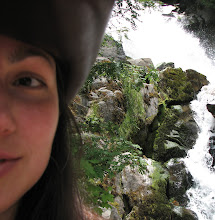While I have known about and followed Rebecca Burgess's Fibershed Project for nearly her full year, I was newly inspired today to see it written up on the Etsy Blog. For anyone who has the least bit of interest in organic and sustainable fashion, Rebecca's quest to wear only garments that have been grown, processed and created within 150 miles of her front door is one that is at once overwhelming and motivational. My own obsession with textiles and clothing design has instilled a certain awareness of what insidiousness is inherent in the fashion industry, but in making such a bold statement towards what is possible, and walking the talk, Rebecca has pretty much reached hero status with me.
 |
| Rebecca's journey reminds me of this book where the authors created the same process around food. |
What I found truly absorbing was how much of our culture, heritage, and sense of community has been lost in exchange for the convenience of the modern food industry. Food and community have always been inextricably linked, and removing the sense of community is having just as damaging an effect on our health as a species as the toxins we are consuming as part of a "conventional" diet. The same is true for the other aspects of our lives that are human needs. Breathing, eating, sheltering and clothing ourselves, if we have let go of our connection to these needs being fulfilled... if we have reached a point where the label in our jeans is more important to the physical, emotional, and way they are affecting our very selves... what is left of the humanity in our species?
That sounds heavy. It is heavy though. I doubt that most people are aware that the textile industry is the world's number one polluter of fresh water. That synthetic dyes produce cancer causing carcinogens. That the slave labour force around the world is largely driven by the fashion industry. While many of our needs are taken care of without much thought on a daily basis, what we wear has a profound effect on how others see us. The fashion industry has made us walking billboards for not only their labels and brands, but also for a certain allowance that we are willing to let our values be rearranged for a smaller price tag, following trends and acceptance in society. Rebecca's stand against that is much farther reaching than simply wanting to wear beautiful and natural clothing, or even for supporting sustainability and the environment. What she is doing is reminding us that working together and building a sense of community should be a part of human need. The process of creating should be inextricably linked with covering the basics of how we live, and that clothing our bodies in this manner should portray that we are healthy, understanding, beautiful people with strong values.
Rebecca notes, "There is a story in each garment, a living history of our collective experience resides in the implications and realities of our clothes. The wool in (one of the) tunic(s) comes from the homestead of Kenny Kirkland. His flock is small in comparison to the flocks that live north and west of us– where 1,000 sheep per ranch is considered normal. In our current system the meat from these animals brings the highest margins, and yields vital wages and income. However, many resources lay wasted in the process of procuring this “one” economically viable product. Making something from the wool is time consuming and proves unaffordable for many ranchers. I wondered…. “At this moment..the great irony and tragedy is that it is too “expensive” to use our own resources…. but in a drastically re-organized economic system which we are entering…… will this remain the case?” What happens when we can’t get everything we need somewhere else?
The Fibershed Project follows the making of the garment, from befriending the sheep or llama that the fiber originates from on its farm, to growing and wild-harvesting the plants that are used in the dying process, to dying, spinning and hand processing the garment. As an ecological restoration educator, textile artist and author, Rebecca was the perfect person to push the idea of creating a wardrobe from local and sustainable fibers and show how it would be a greatly rewarding experience. She has connected with various artisans, farmers and supporters to help her realize her goal.
 |
| Sage steeps in copper dye pots. |
What do you think? Are as inspired as I am? Can you see yourself wearing only gorgeous, handmade artisan clothing? Would you attend dye parties so that you could build up within your community and make a difference? I love any project that puts the locals in the spotlight... and as my community has such an artistic community anyway, I am curious to see how far this could go here... time to start putting out some feelers perhaps.





















No comments:
Post a Comment